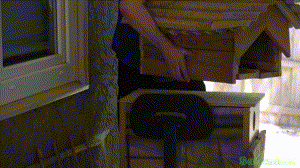A closer look at Solitary Bees Part 5: Adding the pollen collector

In this segment I add another bee house to the stack, this one specializes in collecting pollen. It has screens inside that the bees must pass through and when they do it rakes off a little bit of pollen. This pollen drops down into a tray I can collect and then eat if I wanted. Pollen consumption is a good way to help build a resistance to seasonal allergies I find. Eating local honey and pollen seems to help make spring time not so bad for my sinuses.
In the first part of the video we see bees build more homes using the mud they collect and moving into the bee boards I constructed for them. They do this to make cells for the larva they lay, since every female Mason Bee is a queen they all reproduce in the tunnels they are working in.
Finding their home can be troublesome sometimes, but in the end they usually figure out which tunnel is theirs. They will lay a scent down at the exit of the tunnel so finding it again is easier.
In the second part of this video, I move the bee house to the ground so I can stack the pollen collector house under it. The bees just keep going in as I move them, not minding what I am doing. Also having the bee home up higher the dog cannot stick her snout into their space.
LBRY Video Link
During the few months while these Bees were out and from February through April I brought my tripod outside along with my Lumix GH3 camera, I put my Olympus MSC ED M. 60mm Macro lens on it and just let it record them working hard at their homes.
In this series I will be using a Shure VP83 LensHopper external microphone to capture the sounds of the Bees. A high pitched buzzing can be heard occasionally coming from inside the homes when the Bees are shaking off the pollen they collected. And the video is recorded at 60 FPS for smooth footage of the Bees flying and moving around. Using LBRY as my video platform, the video I rendered is what you get in playback, so there should be little to no loss when viewing.
Two kinds of Mason Bees can be seen entering and leaving the homes. The most easy way to tell which is which is their butts. One has a plain black abdomen (Osmia cornuta) also known as a European Orchard Bee. And the other has a yellow fuzzy abdomen (Osmia leaiana) also known as a Orange-vented Mason Bee.
Previous Parts:
https://peakd.com/hive-123046/@solominer/a-closer-look-at-solitary-bees-part-1
https://peakd.com/hive-123046/@solominer/a-closer-look-at-solitary-bees-part-2
https://peakd.com/hive-123046/@solominer/a-closer-look-at-solitary-bees-part-3-a-fight-breaks-out
https://peakd.com/hive-123046/@solominer/a-closer-look-at-solitary-bees-part-4-completing-the-homes
Addresses below to help me buy better camera equipment and support me to travel to locations to do photo and video and overall great blogs in new places. I would be happy to list some of the contributors in my posts for donations that help me along the way.
| Coin | Address |
|---|---|
 BTC: BTC: | bc1qhfmvd2gywg4fvrgy2kkkkyqta0g86whkt7j8r7 |
 LTC: LTC: | ltc1qdyzm5cwgt8e2373prx67yye6y9ewk0l8jf3ys9 |
 DASH: DASH: | XkSqR5DxQL3wy4kNbjqDbgbMYNih3a7ZcM |
 ETH: ETH: | 0x045f409dAe14338669730078201888636B047DC3 |
 DOGE: DOGE: | DSoekC21AKSZHAcV9vqR8yYefrh8XcX92Z |
 ZEN: ZEN: | znW9mh62WDSCeBXxnVLCETMx59Ho446HJgq |
one day i want to get into bee-keeping, it seems so cool!
These bees are alot easier than honey bees. Im planning on raising the later soon as well.
It has been alot of fun and learning all about how they live.
This job seems to be very difficult. You are struggling. Hope you can do exactly what you want.
Thanks alot.. we shall see how it goes.